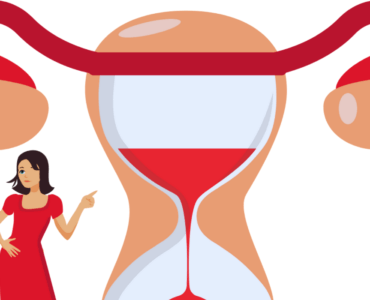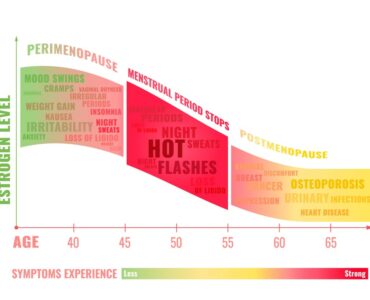Menopause is known as the “shift of life”, and I want you to know that there are many reasons for giving it that name. Medically, menopause is defined as the time in your life when you stop menstruating, for at least 12 months. As you begin this transition to menopause, many other changes occur in your life. You may be juggling multiple roles, and they may all be changing. For example, if you have children, they may be about to leave home or have already done so.

You may be enjoying more time with your spouse or partner now that the nest has been emptied, or you may find yourself looking for a new love. You may have elderly parents who need care. Perhaps you are improving or narrowing your career as you prepare for retirement. And, of course, menopause occurs as you age, which brings with it its own age-related changes. It’s a stressful time, to say the least.
All of this can influence how you experience menopause and the long phase that precedes it, perimenopause. Although changes in your periods are caused by fluctuations in hormones, other symptoms, such as hot flashes and sleep disorders, are likely the result of a combination of factors, including life stress, anxiety, and aging. This stage in a woman’s life can bring other health problems that you have not even thought about.
The unseen health risk — prediabetes
Many women, adding to the burden of perimenopause, carry with them an invisible health risk: prediabetes, a condition in which blood sugar is elevated but not high enough to reach the threshold for diabetes.
Prediabetes affects one in three adults in the United States. However, nine out of 10 people with prediabetes don’t know they have it. This condition often occurs without producing symptoms, allowing it to wreak havoc on your health silently. People with prediabetes have almost the same cardiovascular risks as people with type 2 diabetes. An analysis published July 18, 2020, in The BMJ found that prediabetes increased the risk of developing cardiovascular disease by 15% and death from any cause by 13% during an average follow-up period of approximately 10 years.
The risk of premature death was even higher in people with prediabetes who already had plaque buildup in their arteries. These people had a 36% increased risk of dying in a median follow-up period of just three years. The high blood sugar level seen in prediabetes can also damage the blood vessels in the back of the eye (a condition called retinopathy), leading to blindness.
A high risk of diabetes
If left untreated, prediabetes often progresses irretrievably to diabetes, a condition in which the cells in your body cannot properly absorb glucose (sugar) from the blood. The resulting rise in blood sugar levels can lead to even more health problems. In addition to heart attacks, strokes, and blindness, people with diabetes are also more prone to kidney problems and infections. Trusted sources report that 15% to 30% of people with prediabetes will develop diabetes within five years.
Identifying your risk
s, how can you tell if you are at risk for prediabetes? Should you get a screening test?
If you have any of the following factors, you should take the test:
- A bodyweight categorized as overweight or obesity
- Family history of type 2 diabetes among first-degree relatives, such as a parent or sibling
- A significant history of infrequent and irregular periods, sometimes associated with a condition called polycystic ovary syndrome
- Signs of insulin resistance on the skin, including dark patches in the armpits or neck folds (indicating a condition called acanthosis nigricans) or numerous groups of skin tags
- Gestational diabetes during pregnancy
- Delivery of a baby weighing more than 9 pounds.
- Tests for prediabetes generally take two forms. Postmenopausal women, who are at particularly high risk for prediabetes and diabetes, should ask their doctor to measure their hemoglobin A1c. This test measures the amount of sugar in molecules within your blood cells and can give your doctor an idea about your blood sugar levels for the past three months.
An A1c of 5.7% to 6.4% indicates prediabetes. Other indications of prediabetes are a fasting blood sugar level of 100 to 125 milligrams per deciliter (mg / dL) or a reading of 140 to 199 mg / dL two hours after drinking a drink containing 75 grams of glucose (a process called a glucose tolerance test).
Diabetes is preventable and reversible.
If you have prediabetes, developing diabetes is not a foregone conclusion. You can prevent it. The best way to do this is by adopting a healthier lifestyle.
The Dr. Gala SugarFree Program has helped women with prediabetes adopt intensive lifestyle changes. These people reduced their probability of developing diabetes in the next three years by 58%. Our program combines nutritional counseling, at least 150 minutes of exercise per week, and various cognitive-behavioral modifications, such as learning strategies to reduce stress and adopt healthier and more sustainable eating habits in the long term.
You don’t need to lose a lot of weight to make a difference in your risk for diabetes. High-risk adults who lost just 5% to 7% of their starting body weight, which is about 8 to 11 pounds for a 160-pound woman, reduced their risk of diabetes by 58%.
I invite you to learn more about our program designed especially for you, a woman going through menopause.
Conclusion
Identifying prediabetes early can help you head off diabetes and other long-term health problems.







I have this great believe that knowledge is power. So reading this article, despite the fact that I am not a woman, has really added to my knowledge on menopause. With this knowledge, I am empowered with the ability of educating some else on what menopause is all about. Thanks to you and your writing skills, it was very easy for me to get a better understanding as I went through this article.
Thank you for your valuable comment, Nelson. I appreciate your commitment to increasing awareness among the female community about the importance of understanding the processes ongoing in their bodies.
Even though I am not a women, I feel sympathy to my mother and my sister who will go through this. I have witnessed how they coped with their monthly visit from the cramps to bleeding furiosly. And to think that there is perimenopause in which there is a chance that it could lead to diabetes? Just so sad to know this. Well, I guess I will convince them to adopt a healthy lifestyle then.
Thank you, Tee Teng! It is so nice of you to help create awareness among the women of your family. Most importantly, I would recommend you to let them read the article. Help them adopt a healthy lifestyle.
Hey there!
That is really an amazing and helpful article you have there. Menopause is really a big shift in every woman’s life. It is more like a new era in the life of a woman. I love how well this article elaborated on the subject. Just realized how dangerous prediabetes can be to women approaching their menopause. I hope they attend to it as ought to.
Thanks
Hey, Caro! Thank you for your kind comment. Indeed, menopause is a stage in women’s life. I like to say a special one, for which we should be prepared as early as when we begin our reproductive cycle.